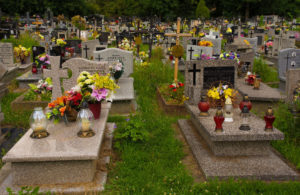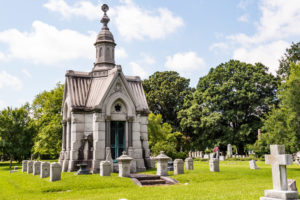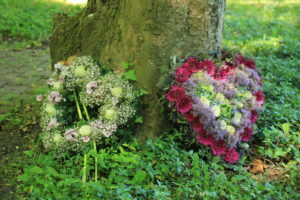How Much Does a Burial Plot Cost?

The cost of a burial plot depends on several factors. The kind of space, type of cemetery, and where you live all play a role in how much you’ll pay. On average, burial plots for caskets range from $525 to $5,000 and $350 to $2,500 for cremated remains in urns.
Table of Contents
Types of Burial Plots
Choosing a burial plot is an important part of the funeral planning process, and there are several options.
Single Space
A single space holds one casket. It’s the most common type of burial plot in cemeteries.
Companion
Companion plots are two spaces bought together that are used to bury two people next to each other. They’re used most often for married couples. There are two options for companion spaces.
Side-by-Side
These plots lie side by side. You may have to pay the full price of two spaces, but some cemeteries offer a discount on multiple purchases.
Double-Depth
This type of grave is a single space that stacks two caskets on top of each other. They’re usually cheaper than side-by-side spaces, but they may come with added fees for reopening and reclosing the grave if the owners pass away at different times.
Family
A family plot is a group of spaces used to bury multiple family members. Plots may be purchased in a row or in a square- or rectangle-shaped area in the cemetery. Rows feature either one long headstone with the family name along with each individual’s name, or they may feature a line of traditional headstones. Areas usually contain one large headstone with the family name engraved on it and smaller headstones for each family member.
Plots for Cremated Remains
Most cemeteries have urn gardens that contain plots to bury urns. These spaces are smaller than those used to bury caskets, so they’re less expensive.
Plots for cremains are sometimes the same standard spaces bought for caskets. You can sometimes bury more than one urn in a single plot with this option.
In either case, you may be required to buy an outer burial container for the urn.
Lawn Crypt
In this type of plot, cement, marble, bronze, steel, or another solid material lines the grave. Caskets are better protected this way, especially in areas that are prone to floods. This option can be used in single, double-depth, or family plots.
Mausoleum Crypt

Mausoleum crypts hold remains above ground in a tomb, called entombment. There are three different kinds:
- Indoor - These spaces are inside or under churches or other buildings. Many caskets and/or urns from several different families are kept in them, so they’re sometimes called community mausoleums.
- Outdoor - These are individual buildings in cemeteries where many caskets and/or urns from several different families are kept.
- Private - A single person or family uses these indoor or outdoor crypts.
Mausoleum crypts are also available in many different forms, no matter if they’re indoor, outdoor, or private:
- Single space - This holds a single casket.
- Side-by-side - Two caskets lie next to each other.
- End-to-end - This is a type of companion crypt similar to burial’s double-depth plot, but caskets lie end to end rather than stacked on top of each other.
- Westminster - Also called a family crypt, this holds as many people as you wish, usually family members. Caskets may be placed side by side, end to end, or on top of one another. Each one may have its own marker, or there may be one large marker for the whole family.
Columbarium
Columbariums are similar to mausoleum crypts, but they’re only used to entomb cremated remains. They use niches (wall spaces) to hold urns and may be located indoors or outdoors. Columbariums are locked, but they sometimes have glass or plastic exteriors to display urns.
Private Mausoleum
Private mausoleums are large areas in cemeteries devoted to one family, and they contain multiple burial sites. They can be outdoor spaces that include a combination of below- and above-ground burial plots, or they can be individual buildings that hold the remains of a single family. Many people choose to add personal touches, like statues, benches, plaques, or custom memorials. Private mausoleums are blocked off by gates, fencing, shrubs, or other structures to ensure privacy.
Veteran
Qualified veterans can use the burial benefit from the US Department of Veterans Affairs (VA) to obtain a veteran plot. In addition to a burial space at one of the 144 cemeteries owned by the VA, families of vets can receive these benefits to bury their loved one free of charge:
- Grave opening and closing
- Ongoing gravesite care
- Headstone
- Burial flag
- Presidential Memorial Certificate
Spouses and dependants of veterans can also be buried alongside the vet at no cost.
Plots for Green Burials
Green burial plots hold unembalmed bodies in natural containers. Both the body and the biodegradable casket naturally decompose in the ground.
Pre-Owned
Pre-owned burial plots are sold by private individuals who pre-purchased a plot. Many people pre-plan their funeral and burial but later change their plans because they divorce, remarry, or move out of the area. Other people run into hard times financially and sell their plot to bring in some money. In any case, you can usually buy them for a discounted price.
Average Plot Cost by Type of Cemetery
The average cost of a plot depends on many factors. These may include:
- Whether the cemetery is public or private
- Plot size
- The location of the space in the cemetery
- Where you live (areas with high living costs also have high prices for final arrangements)
With that in mind, there are national average costs you can use to guide you when shopping for a burial site. These prices are for single spaces, so if you buy a side-by-side companion plot, you may pay double the price.
Prices for mausoleum crypts, columbariums, and private mausoleums usually have costs in the price ranges listed below. However, you’ll pay extra fees for structures, decorations, and extra land, and the price for each varies. If you’re interested in any of these options, ask for a broken-down price list from any cemetery you’re considering working with.
Public Cemetery Plot
Public cemetery plots are best for those with small budgets. They cost an average of $525 to $2,500.
Public Burial Plot for Cremated Remains
Smaller spaces for urns are less expensive, costing about $350 to $500.
Private Cemetery Plot
Private cemeteries cost much more than public cemeteries. You can expect to pay between $2,000 and $5,000 for a space. In some places, especially major urban areas, prices can be as high as $25,000 for a single space and $50,000 for a double-depth companion plot.
Private Burial Plot for Cremated Remains
Burying cremains is also more expensive in private cemeteries, costing between $1,000 and $2,500.
Green Burial Plot

Green burial plots for caskets cost an average of $1,000 to $4,000. Along with a burial space, it usually includes:
- Interment
- Grave marker
- Perpetual care of the site
Cremated remains can also be buried in green cemeteries without an urn. The average price for this type of plot is $200 to $1,000.
You can save a lot of money with green burials. There is no need to embalm or even cremate the body, and biodegradable caskets are much cheaper than traditional options. Cutting these costs trims a lot off the average cost of a funeral, which is between $7,000 and $9,000.
Pre-Owned Burial Plot
The cost of a pre-owned burial plot is set by the owner. The price will vary on factors including:
- The cemetery’s desirability
- The plot’s location within the cemetery and its desirability
- How much the owner paid for it
- How quickly the owner wants to sell it
The more in demand the location of the plot is, the higher the price. However, if the owner is eager to sell it, you may be able to get a better deal.
Additional Burial Plot Costs to Consider When Budgeting
Along with the type of cemetery and the size and type of the gravesite you choose, there are other factors that can impact the cost of a plot. These include:
- Your location - Plots in rural areas are cheaper than those in urban locales.
- Competition - Coveted cemeteries and areas within them have higher prices than less-desirable places.
- Plots for infants and children - These are usually less expensive than spaces for adults.
Plus, there are costs a lot of people think are included in the price of a burial plot, but they usually aren’t. Be sure you’ve included these costs in your funeral planning checklist.
| Item or Service | Description | Price Factors | Cost |
| Grave Marker / Headstone | Marks the place of burial and lists details about the deceased | Size Material Design | Flat: $1,000 Upright: $2,000 - $5,000 |
| Headstone Installation | Placement of a headstone at the gravesite | Size and material of headstone; the more difficult it is to place, the higher the price | $100 - $325 |
| Interment | The physical burial and its administration costs, including:
| Individual cemetery | Public cemetery: $350 - $1,000 Private cemetery: $600 - $3,000 |
| Grave Liner / Burial Vault | Protective material that surrounds the casket or urn in the grave | Material | $550 - $7,500 |
| Burial Permit | Permit required by some local governments at the city, county, and/or state level to dispose of a body by burial or cremation | Geographical location | $20 |
| Maintenance | Maintenance of the gravesite and cemetery grounds | Size of cemetery Public or private cemetery | Varies |
FAQs
How long do you own the cemetery plot?
In most cases, when you buy a plot, you own it forever. There are some states with laws that allow them to reclaim the space if a certain amount of time passes with no activity at the gravesite. This time span is usually 50 years or more. Check with your estate attorney to see if this type of law applies to you.
What is a prepaid burial plot?
People purchase prepaid burial plots as part of their funeral planning. Since funeral costs tend to rise each year, this is a strategic way to save your loved ones money after you pass away, especially if you don’t have burial or funeral insurance or another life insurance policy to help cover your final expenses.
How many people can be buried in one plot?
The number of people allowed in a single space depends on the plot, cemetery, and body disposal method:
- Single-space plots hold a single casket with one body.
- Double-depth companion plots hold two stacked caskets.
- A single urn is usually buried in a plot specifically designed to hold urns (like in urn gardens). Multiple urns with cremated remains can sometimes be buried in a traditional single space in a cemetery.
How do I buy a burial plot?
If you’re pre-planning your own funeral and burial or choosing where to lay a loved one to rest, take these steps to select the best plot for your needs.
- Do online research of cemeteries in your area. Look at photos of each one, and ask yourself:
- Can it accommodate your pre-paid funeral plan?
- Does it offer the specific type of burial plot you’re looking for?
- Is the cemetery in a location that’s easy to get to?
- Does it have grounds that look well-kempt?
- Are there roads and other pathways that make it easy to get to each grave site?
- Does it have the features you are looking for, such as sitting areas?
- Does it have good reviews?
- Have there been any serious complaints filed against it with a consumer advocacy group like the Better Business Bureau (BBB)?
- Once you’ve put together your short list, check with your city, county, or state government to verify each cemetery’s license.
- Visit the cemeteries you’re interested in. Meet with a representative so you can get a copy of the bylaws and ask questions about:
- Which particular plots are available
- Visiting hours
- Rules for grave decorations and memorials
- Who is responsible for maintaining the gravesite
- Visit the plots that are available. At each one, consider:
- Is the location quiet, or is there a lot of noise from traffic or nearby neighborhoods?
- Do the grounds look as nice as they did in the photos?
- Get a broken-down price list for all burial fees discussed in this article.
- Ask about discounts. The funeral home you work with may have a relationship with your chosen cemetery. The cemetery may also offer other discounts, like for veterans or for those purchasing multiple plots.
- Work with your estate attorney to finalize the paperwork. They’ll review the terms of your agreement and help you get any needed permits.
What else should I consider when buying a burial plot?
In addition to costs, there are other factors you should consider when buying a burial plot, including:
- Rules and bylaws of the cemetery - It may have rules about grave markers, decorations, plot maintenance, and visiting hours that don’t fit your needs.
- Cemetery expansion plans - If a cemetery plans to expand its grounds, you may not want a plot next to an area it’s building out.
- Available payment plans - If you’re pre-planning your funeral, you may be able to pay the cost of your plot in installments. Keep in mind this is a loan, so you may have to pay interest, late fees, or other costs.
Can I transfer a burial plot I buy?
Most of the time, you can transfer a space after you purchase it, because you’re not buying actual property. You’re buying the right to bury yourself or a loved one, so many plots are transferable. If this is an option you think you may want to use someday, be sure to discuss it with a cemetery representative before purchasing your space.




